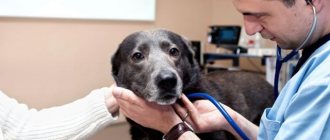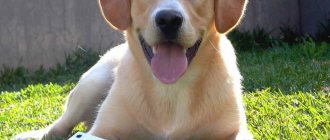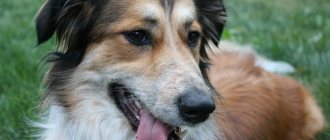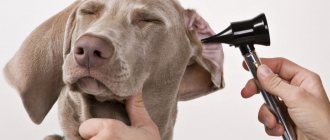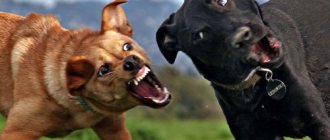Taking care of your pet's health is an important part of caring for your dog. Most owners pay close attention to the well-being of their pet and are ready to run to the doctor as soon as their beloved four-legged friend falls ill.
However, there are symptoms that are not so easy to discern even for a knowledgeable and attentive owner. What hidden signs of illness may indicate that not everything is all right with your four-legged friend?
Increased thirst. If increased fluid intake is not associated with high room temperatures or excessively salty foods, thirst may be a sign of increased toxins in the body or endocrine system dysfunction. Another serious disease in which this symptom appears is kidney failure, leading to severe damage to the urinary system and even death of the pet. In any case, if the thirst does not go away within a day or two, we advise you to immediately show your dog to a veterinarian.
Frequent urination. Often increased thirst is accompanied by a frequent urge to urinate. It is difficult to ignore this symptom, but most owners do not consider it a sign of a serious illness. In fact, this phenomenon may be a sign of cystitis (if the urge is frequent and the amount of urine released is insignificant) or urinary incontinence.
Pallor or even blueness of the mucous membranes. This symptom is usually accompanied by weakness and a staggering gait. If at the same time you notice that your dog’s belly is increasing in volume, go to the veterinarian without wasting a minute. All these are signs of severe internal bleeding, in which life can count for hours.
Lack of appetite. This is a truly serious symptom for a responsible owner. The first thing to do if the dog refuses to eat is to examine the animal’s body in search of a tick, because lack of appetite and lethargy are one of the first signs of piroplasmosis. However, even if you don’t find a parasite, you shouldn’t relax - watch your dog carefully and, if you notice other signs of ill health, immediately run to the doctor. To be fair, it must be said that our beloved pets often refuse food, even when they are completely healthy. It is quite possible that the dog simply decided to have a fasting day.
Increased appetite, accompanied by a sharp weight loss of the animal, may be a sign of diabetes mellitus or helminthic infestation. In the first case, the pet needs carefully calculated insulin therapy, and in the second you will have to rid it of internal parasites.
Hair loss all over the body and the appearance of large dandruff. These symptoms of demodicosis may also be accompanied by itching and general nervousness of the dog. If you notice one or more of these signs, submit a deep scraping from your pet’s skin to a veterinary laboratory - treatment directly depends on the type and number of demodectic mites that have infected the dog.
Frequent vomiting and loose stools, especially on an empty stomach. Often, owners do not pay attention to vomiting and diarrhea, justifying it with banal overeating or the ingestion of not entirely fresh food. In fact, such symptoms, which are repeated with enviable regularity, most often indicate severe damage to the digestive system such as gastritis, pancreatitis or cholecystitis. Despite the fact that your pet is not in immediate danger of death, it would be a good idea to consult a doctor as soon as possible and prescribe treatment with enzymes.
Increased salivation. Increased salivation can occur with sunstroke or heatstroke, as well as with injuries to the tongue and oral cavity. Another reason for this phenomenon is the entry of a foreign body into the dog’s stomach; in this case, there is also frequent regurgitation of freshly eaten food and water.
Inflammation of the mucous membrane of the eyes. In addition to a foreign body or staphylococcal infection, eye inflammation can be a sign of liver disease or gallbladder pathology. If all kinds of eye treatments do not bring results, try to look at liver indicators in tests and, if necessary, begin treatment for this vital organ.
Lameness. In addition to the expected bruise or fracture, a dog can limp due to such an insidious and invisible disease as arthritis. In this case, this sign occurs in damp, cold weather or in case of sudden hypothermia of the animal. If your four-legged friend runs with his hind legs together like a hare, this is a clear symptom of hip dysplasia, an incurable hereditary disease that requires lifelong therapy.
Cough and respiratory distress, especially in an older dog. Such symptoms indicate acute or chronic heart failure, as well as fluid accumulation in the chest.
Purulent discharge from the loop. Most owners know how dangerous pyometra is - purulent inflammation of the uterus in dogs. And that the first sign of this disease is purulent discharge from the vagina of a bitch. However, few people are able to notice such a symptom in time, paying little attention to what is happening under the tail of their beloved dog.
The animal behaves restlessly at night, whining or walking in circles around the room. Such signs are not a whim at all, but rather well-known symptoms of increased intracranial pressure. It can occur after epileptic seizures, trauma, or problems with the heart or blood vessels. This condition can be diagnosed by CT or MRI, carried out in all major veterinary clinics.
Unnatural dog posture while resting. An animal that is not bothered by anything rests and moves naturally. The dog sleeps curled up in a tight ball when it is cold and stretches out its limbs in a warm room. In case of any pain syndrome, the animal takes a forced position, in which the pain is reduced and the unpleasant symptoms disappear. If you notice that your pet is sleeping or walking differently than before, be sure to show him to the veterinarian, perhaps something is really bothering him.
Yellowness of the mucous membranes and skin. This symptom is difficult to notice, especially on black animals. However, an attentive owner will notice that the sclera of the pet’s eyes and gums have acquired an unhealthy yellowish color. Most often, such jaundice is provoked by liver diseases, including cirrhosis, so do not delay your visit to the veterinarian. However, such a symptom can also arise for a completely innocent reason. Yellowness of an animal's skin may indicate an excess of carotene in the body. Of course, any hypervitaminosis is an unpleasant phenomenon and requires nutritional correction, however, compared to cirrhosis, it is a fairly innocent thing.
Pica. A dog's devouring of all kinds of inedible objects is most often provoked not by a lack of education, as some people think, but by serious health problems. Most likely, your pet is worried about digestive disorders, however, a perverted appetite can also be a sign of more serious diseases - for example, rabies.
Most of the symptoms presented above may well be harmless in nature and are not signs of serious diseases. However, the health of your beloved pet is not a matter of guesswork or hope. If you see any of them or feel that the dog’s behavior has changed, immediately show it to a doctor. Even if the alarm was false, you will get rid of worries, and the slightest unpleasant surprise will not take you by surprise.
Psychological causes of restless behavior in dogs
A dog's restless behavior is a signal to be alert and analyze its general condition. It is important to understand that the causes of restless behavior can be physiological and psychological.
For physiological reasons, the dog is anxious due to discomfort. Most often, the “root of the problem” is that the dog cannot sleep properly, suffers from chronic fatigue and lack of self-confidence.
The psychological causes of restless behavior in dogs are very multifaceted and most often complex, so their diagnosis is extremely difficult.
Diagnosis of mental disorders is associated with a number of difficult issues:
- You need to make sure that the dog is completely physically healthy - this is almost impossible.
- It is necessary to carefully track the history and analyze what events preceded changes in behavior.
- It is necessary to carefully analyze the environment, including ecology, climate, quality of the food the dog eats, etc.
The only psychological reason that is commonly used to “denote” restless behavior is stress. Usually, the diagnosis is confirmed or removed after a trial course of sedatives.
Restless behavior as a sign of illness
Restless behavior as a sign of disease is the first assumption that is analyzed by the veterinarian. If, against the background of anxiety, the dog looks tired and less active, most likely the reasons really lie in physical discomfort.
However, there are exceptions and controversial points. So-called psychosomatic diseases are mental disorders that cause real physical consequences.
Due to anxiety and/or stress, the dog develops a physical illness. Contrary to popular belief, psychosomatic diseases develop rapidly, so their timely diagnosis is extremely important for full rehabilitation.
Additional symptoms and their explanation
If your restless behavior is due to physical illness, you may be able to look for additional symptoms.
The dog is rushing about and cannot find a place for itself
If the dog is rushing about and cannot find a place for itself, the reasons may be:
- Stress.
- Sounds that the dog hears but you don’t and/or other irritating factors.
- Phobias.
- Physical pain.
A sudden change in behavior and the appearance of anxiety may be associated with recent stress or very real irritating factors. If you live in an apartment, your dog may suffer from ultrasonic repellers installed by your neighbors. The pet can hear footsteps in neighboring apartments and smell animals.
Note! If a dog of the opposite sex lives in the same building as you, your pet may become very restless during the heat period.
Phobias require long-term correction and constant participation of the owner. Physical pain occurs against the background of diseases, the diagnosis of which must be carried out by a doctor.
The dog is restless at night
If your dog is acting restless at night, the likely causes are:
- Irritating factors in neighboring homes or on the street.
- Lack of physical activity.
- Sluggish chronic diseases, such as arthritis.
Restless behavior at night is often encountered by owners who work and do not devote enough time to walking their dog. After a short morning walk, you go to work, and your bored pet goes to bed. Thus, the dog is at rest all day, goes for a short walk in the evening and has nowhere to put its energy.
Note! Being active at night is a way to attract the owner's attention.
If the animal itches
The animal itches and looks restless for the following reasons:
- Prolonged stress.
- Obvious mental disorders.
- Parasites.
- Allergy.
With obvious mental disorders, the dog scratches the skin until it bleeds. Quite often, you can observe your pet licking its front paws. When the dog is excited, he often and nervously licks his muzzle. Such conditions can be treated with long-term therapy, massage, changes in feeding and walking schedules, and increased attention from the owner.
Your dog may be itchy and anxious if he is infested with fleas, ticks, or other parasites. To protect your pet from unwanted “neighbors,” you need to carry out preventive measures once every 1–3 months, depending on the drug chosen.
The dog is nervous before traveling or in the car
Severe anxiety before traveling or in the car is a natural reaction of a dog. It is important to understand what a pet experiences if its trajectory of movement is not under control.
Note! Before and during travel, veterinarians recommend the use of sedatives.
Breathes frequently with mouth open
When a dog is anxious and frequently breathes with its mouth open, the reason is overexcitement or an increase in body temperature. Overexcitement does not always threaten the pet's health, since the dog can experience strong emotions of a positive nature.
The dog has its tail between its legs
If your dog is anxious and has a tucked tail, the most likely reason is:
- Self-doubt.
- Competitive environment.
- Physical pain that causes the dog to feel insecure.
A tucked tail can indicate distress or a willingness to submit. To determine the real reason, the dog's behavior must be analyzed comprehensively.
Weaning methods
Let's look at how to stop a dog from whining if it is not caused by pain or a painful condition. You can use various techniques so that the dog stops making drawn-out plaintive sounds, irritating household members and neighbors. There are several effective techniques.
Ignoring
By whining, the puppy is trying to attract attention. If you constantly react and try to calm him down, he will take advantage of it. In this case, the whining will never stop. Ignoring it usually helps, and over time the squealing will stop. A good place to start is by placing your puppy's bedding next to your bed so he knows he's not alone. Over time, you should gradually move it away until it is where it should be. The main thing is to remain calm and never reward your dog when he whines. The best way out is to completely ignore or ban.
Ban
If, with age, the dog behaves restlessly (especially when left alone) or whines at night, then you should start weaning it using the “fu” command. As soon as she starts whining or squealing, go up to her, give her a command and lightly slap her on the rump. If the whining stops for a short time, you should approach, praise and give a treat. If the dog's yelping resumes, remain calm and repeat the exercise until the effect is achieved.
Walk before bed
Before going to bed, it is recommended to take your pet for a walk and then feed him, making sure that he does not overeat. A well-fed and well-fed dog should sleep peacefully all night.
Distraction and play
If the puppy does not want to sleep at night, then you should put your favorite toys or familiar things next to him. By being distracted by them, he will stop whining and fall asleep unnoticed. It is also recommended to take toys or teeth sharpeners with you when traveling.
It is worth remembering that you should never resort to physical punishment. Such actions can only worsen the situation. Fear or aggression are bad helpers, and forming a relationship with a four-legged friend should not be built on their basis.
Factors that provoke restless behavior in dogs
Quite a lot of situations lead to a dog being excited, which can provoke anxiety. Let's look at the factors that provoke restless behavior in dogs.
Anxiety after birth in nursing dogs
Concern after birth in nursing dogs is quite natural, since the young mother is worried about the safety of her offspring. In addition, dogs, like people, have very affectionate feelings towards puppies, so they may become worried when babies squeak and become active.
Anxiety during heat
It's natural to feel anxious during heat, as your dog experiences very real physical discomfort. It is especially difficult for dogs during their first heat, as they feel constant nagging pain in the lower abdomen and a frequent urge to urinate.
How to calm a dog at home?
In some cases, the owner's direct involvement is required, and sometimes the dog needs to be left alone or isolated.
To calm your dog, try calling your pet, talking to him and tracking his reaction. If the dog calms down, great; if not, use the opposite tactic. Take the dog to a bed and leave it alone, observe the changes. If your pet falls asleep, most likely he is hyperactive because he is suffering from overfatigue.
In case of strong excitement, the dog may show aggression or behave completely inappropriately. The only most gentle method to calm a pet is to isolate it in a separate room and not show emotions in response.
If a dog looks nervous all the time, itches, licks its paws, and does not listen, a comprehensive approach is required to help. At home, you can use standard sedatives (strictly according to the instructions). Another method of help is to increase the duration and activity of walking; the more tired the dog is, the faster it will fall asleep after returning home.
What to do
Now that we've narrowed down the reasons why dogs walk and won't lie down, you'll want to know if there's a way to reduce this behavior in your pet.
- Get a diagnosis and prescribe treatment
- Pay attention to your dog
- Spay or neuter your dog
- Play games with your dog
- Try to reduce stress
- Comfort your best friend
Between you and your trusted veterinarian, there are many methods that can be used to reduce your dog's stimulation.
In what cases is a visit to the clinic strictly necessary?
In what cases is a visit to the clinic strictly necessary:
- The dog is in obvious pain.
- The pet developed wounds, scratches, and eczema.
- There are strong changes in appetite.
- The dog refuses water.
- There is a sharp gain or loss of weight.
- The dog is suffering from fever.
- There are signs of allergy or intoxication.
- The dog's mucous membranes turn blue when excited or when it calms down.
It is important to understand that constant anxiety will remain a psychological problem “for the time being.” Stress can cause or exacerbate diseases of absolutely any type. It has been proven that dogs that constantly live in a stressful environment are more prone to contracting viral, infectious and even colds.



